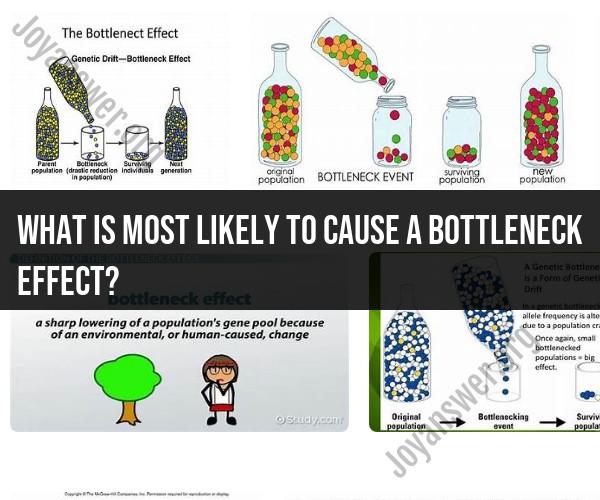What is most likely to cause a bottleneck effect?
A bottleneck effect in population genetics occurs when a significant portion of a population is suddenly reduced in size, leading to a decrease in genetic diversity. This reduction in genetic diversity can have long-term consequences, including an increased risk of genetic disorders and reduced adaptability to changing environmental conditions. Several factors can induce a bottleneck effect:
Natural Disasters: Natural disasters such as earthquakes, tsunamis, hurricanes, or wildfires can lead to population bottlenecks. These events can result in the loss of individuals and a sudden reduction in population size.
Disease Outbreaks: A widespread outbreak of disease can rapidly reduce the population of a species. Infectious diseases can be particularly devastating if they have a high mortality rate.
Hunting and Overexploitation: Excessive hunting, fishing, or harvesting of a species can lead to population declines and bottlenecks. This is particularly true for species with slow reproductive rates.
Habitat Destruction: The destruction or fragmentation of natural habitats due to human activities like deforestation, urbanization, and construction can isolate populations and reduce their size.
Genetic Drift: Even in the absence of external factors, random genetic drift can cause a bottleneck effect. Genetic drift occurs when certain alleles become more or less common in a population due to random chance.
Founder Effect: When a small group of individuals establishes a new population in a different area, it may carry only a fraction of the genetic diversity of the original population. This reduced genetic diversity is known as the founder effect.
Catastrophic Events: Events such as volcanic eruptions, asteroid impacts, or extreme climate changes can lead to population bottlenecks on a large scale, affecting multiple species simultaneously.
Genetic Engineering: In the context of biotechnology, genetic engineering techniques that involve creating genetically identical individuals (clones) can result in a bottleneck effect by limiting genetic diversity.
Inbreeding: In small populations, individuals may be more likely to mate with close relatives, leading to inbreeding. Inbreeding can reduce genetic diversity and increase the expression of harmful recessive traits.
Small Founder Populations: When a new population is founded by only a few individuals, it may start with limited genetic diversity, making it susceptible to the effects of genetic drift and inbreeding.
It's important to note that the severity and duration of a bottleneck effect can vary. Some populations may recover over time, while others may face long-term challenges due to reduced genetic diversity. Conservation efforts often focus on mitigating the effects of bottlenecks and promoting genetic diversity to ensure the resilience and adaptability of populations.
Pinpointing the Causes: Factors Most Likely to Create Bottleneck Effects
Bottlenecks are any constraints in a workflow that slow down or prevent the flow of work. They can occur anywhere in a process, from the beginning to the end.
Some of the most common factors that lead to bottlenecks include:
- Limited resources: This could include people, equipment, or materials. If there are not enough resources available to complete a task, it will create a bottleneck.
- Unclear or inefficient processes: If the processes in place are not clear or efficient, it can lead to bottlenecks. This could be due to a lack of communication, poor planning, or outdated procedures.
- Errors and rework: If errors are made or work needs to be redone, it can create a bottleneck. This can be due to lack of training, poor quality control, or inadequate tools and equipment.
- Capacity constraints: If the capacity of a system is not sufficient to meet the demand, it can create a bottleneck. This could be due to a lack of space, equipment, or staff.
- Unforeseen events: Unexpected events, such as equipment failure or power outages, can also create bottlenecks.
Bottleneck Sources: What Leads to Slowdowns and Inefficiencies
Bottlenecks can lead to a number of problems, including:
- Increased costs: Bottlenecks can lead to increased costs due to delays, rework, and lost productivity.
- Reduced customer satisfaction: Customers are not happy when they have to wait longer for products or services.
- Increased stress and frustration: Employees who are constantly dealing with bottlenecks can experience stress and frustration.
- Reduced morale: Low morale can lead to decreased productivity and increased turnover.
Navigating Bottleneck Challenges: Solutions for Improved Workflow
There are a number of things that can be done to identify and address bottlenecks:
- Identify the bottlenecks: The first step is to identify where the bottlenecks are occurring. This can be done by tracking the flow of work and looking for areas where there are delays or queues.
- Understand the causes: Once the bottlenecks have been identified, it is important to understand the causes. This will help to develop solutions to address the problem.
- Implement solutions: There are a number of solutions that can be implemented to address bottlenecks. These include:
- Reducing demand: If the demand for a product or service is too high, it may be necessary to reduce demand in order to avoid bottlenecks.
- Increasing capacity: If the capacity of a system is not sufficient to meet demand, it may be necessary to increase capacity. This could involve adding more staff, equipment, or space.
- Improving processes: If the processes in place are not efficient, they can be improved. This could involve simplifying processes, streamlining workflows, or using new technologies.
- Error prevention: Errors can lead to bottlenecks, so it is important to focus on error prevention. This could involve training employees, providing quality control measures, and using preventive maintenance.
- Planning for contingencies: Unforeseen events can lead to bottlenecks, so it is important to plan for contingencies. This could involve having backup plans in place or working with suppliers to ensure that they can meet demand in the event of a disruption.
By taking steps to identify and address bottlenecks, businesses can improve their workflow and reduce costs, improve customer satisfaction, and increase employee morale.













